Emphasis on Component ((Product (Professional/Industrial Printer, Personal/Desktop 3D Printers), Material (Polymer, Plastic, Metals and Alloys, Ceramic, Other Materials), Technology ( Stereolithography, Selective Laser Sintering, Electron Beam Melting, Fused Deposition Modelling, Laminated object Manufacturing, Other Technologies))
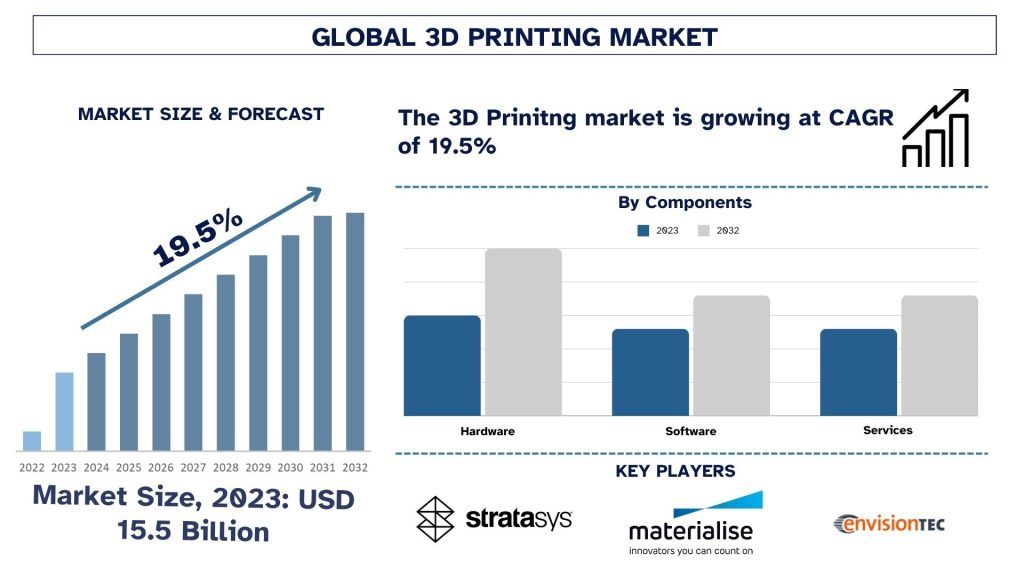
The 3D Printing Market was valued at approximately USD 15.5 Billion in 2023 and is expected to grow at a robust CAGR of around 19.5% during the forecast period (2024-2032). The growth of the 3D printing market is driven by technological advancements, increasing demand for customization, cost-efficiency, and rapid prototyping across industries.
The increasing demand for 3D printing is also driven by its long-term cost-effectiveness, customization, speed, flexibility, and sustainability. As technology continues to improve and new applications are discovered, the demand for 3D printing is likely to continue to grow. 3D printing allows for the creation of unique and customized products, which is particularly appealing to consumers who want personalized items. Further on, 3D printing allows to produce complex shapes and geometries, which can be difficult or impossible to achieve using traditional manufacturing methods. Also, it can reduce waste and the carbon footprint of production, as it only uses the exact amount of material needed to produce a given object.
3D Printing Market Trends
This section discusses the key market trends influencing the 3D Printing segments as identified by our research experts.
Fuel Deposition Modelling Transforming Industry
By technology, the market is segmented into fuse deposition modeling, selective laser sintering, material jetting, stereolithography, and metal sintering. The fuse deposition modeling segment captured more than 50% share of the 3D Printing market in 2023 owing to the extensive adoption of the technology across various 3D printing processes. Further, the growing demand from aerospace and defense, healthcare, and automotive verticals would open opportunities for the adoption of these technologies.
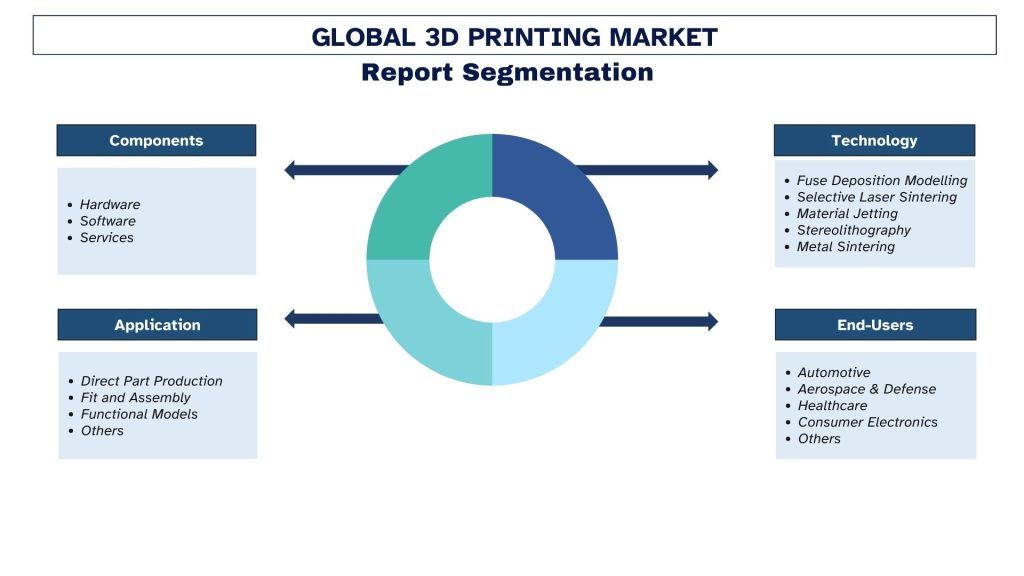
North America is expected to Dominate the Market.
3D printing technology has gained vastly in prominence over traditional manufacturing methods in North America due to its efficiency and high precision rate. Considering the rapid growth prospects of the region in every aspect, the region continued to dominate the 3D industry in terms of market share in 2023. Furthermore, the growth in the region can also be attributed to efficient utilization of materials, time and cost efficiency, the drastic surge in customization of 3D solutions, and burgeoning technical upgradation coupled with the region’s economic potential to make consistent investments in emerging economies.
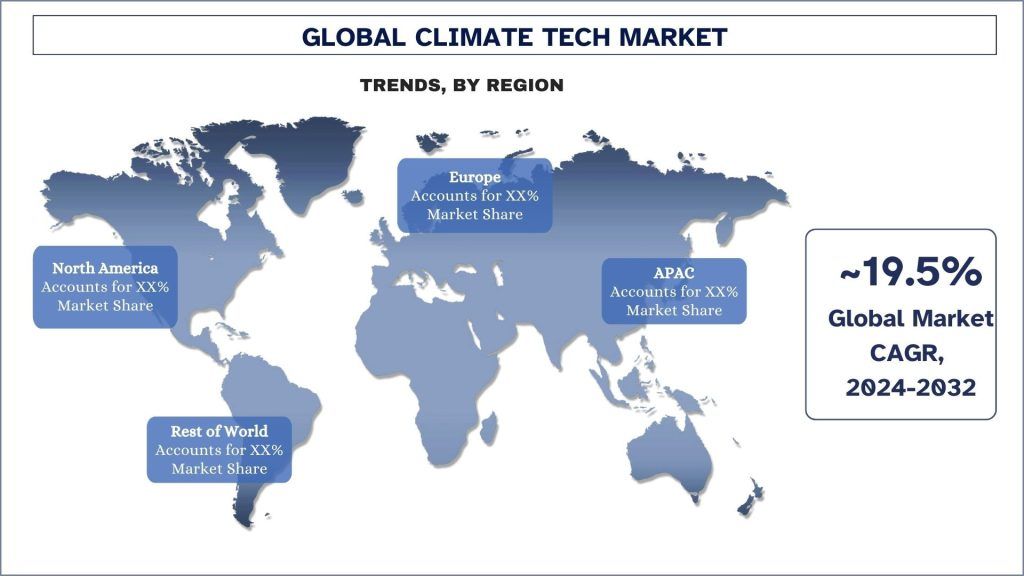
3D Printing is competitive, with several global and international market players. The key players are adopting different growth strategies to enhance their market presence, such as partnerships, agreements, collaborations, new product launches, geographical expansions, and mergers and acquisitions. Some of the major players operating in the market are Stratasys, Materialise, ENVISIONTEC US LLC, 3D Systems, Inc, General Electric Company, Autodesk Inc., Canon Inc., voxeljet AG, HP Development Company, L.P., ExOne. Several M&As along with partnerships have been undertaken by these players to facilitate customers with hi-tech and innovative products/technologies.
For instance, in 2024, Xolo has introduced the Xube² 3D Volumetric Printing system, with the company promising ‘unparalleled speed and resolution.’ Volumetric 3D printing allows objects to be built in a single, layer-free process and is said to offer significant speed and material efficiency advantages.
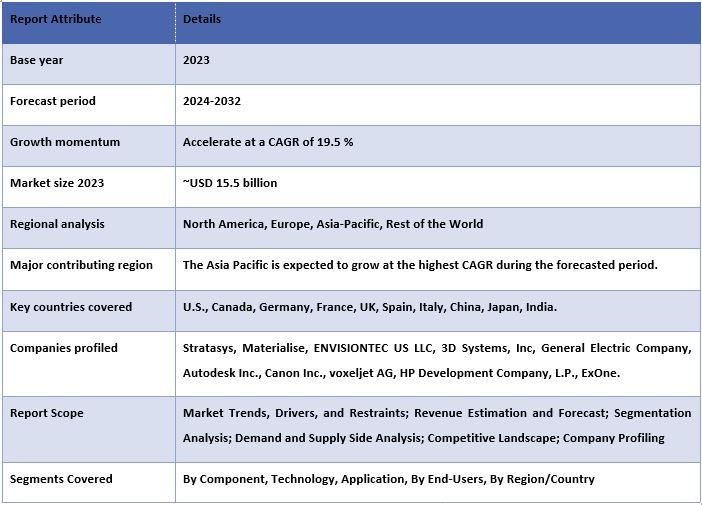
The Global 3D Printing can further be customized as per the requirement or any other market segment. Besides this, UMI understands that you may have your own business needs; hence, feel free to connect with us to get a report that completely suits your requirements.
1. Market Introduction
2. Research Methodology Or Assumption
3. Executive Summary
4. Market Dynamics
5. Pricing Analysis
6. Global 3d Printing Market Revenue (usd Bn), 2022-2032f
7. Market Insights By Components
8. Market Insights By Technology
9. Market Insights By Application
10. Market Insights By End-users
11. Market Insights By Region
12. Value Chain Analysis
13. Competitive Landscape
14. Company Profiled
15. Acronyms & Assumption
16. Annexure
Analyzing the historical market, estimating the current market, and forecasting the future market of the global 3D Printing market were the three major steps undertaken to create and analyze the adoption of 3D Printing in major regions globally. Exhaustive secondary research was conducted to collect the historical market numbers and estimate the current market size. Secondly, numerous findings and assumptions were taken into consideration to validate these insights. Moreover, exhaustive primary interviews were also conducted, with industry experts across the value chain of the global 3D Printing market. Post assumption and validation of market numbers through primary interviews, we employed a top-down/bottom-up approach to forecasting the complete market size. Thereafter, market breakdown and data triangulation methods were adopted to estimate and analyze the market size of segments and sub-segments of the industry. Detailed methodology is explained below:
Step 1: In-Depth Study of Secondary Sources:
A detailed secondary study was conducted to obtain the historical market size of the 3D Printing market through company internal sources such as annual reports & financial statements, performance presentations, press releases, etc., and external sources including journals, news & articles, government publications, competitor publications, sector reports, third-party database, and other credible publications.
Step 2: Market Segmentation:
After obtaining the historical market size of 3D Printing, we conducted a detailed secondary analysis to gather historical market insights and share for different segments & sub-segments for major regions. Major segments are included in the report, such as component, technology, application, end-users, and region. Further country-level analyses were conducted to evaluate the overall adoption of testing models in that region.
Step 3: Factor Analysis:
After acquiring the historical market size of different segments and sub-segments, we conducted a detailed factor analysis to estimate the current market size of the 3D Printing market. Further, we conducted factor analysis using dependent and independent variables such as component, technology, application, end-users, and 3D Printing regions. A thorough analysis was conducted of demand and supply-side scenarios considering top partnerships, mergers and acquisitions, business expansion, and product launches in the 3D Printing market sector across the globe.
Current Market Sizing: Based on actionable insights from the above three steps, we arrived at the current market size, key players in the global 3D Printing market, and market shares of the segments. All the required percentage shares split and market breakdowns were determined using the above-mentioned secondary approach and were verified through primary interviews.
Estimation & Forecasting: For market estimation and forecast, weights were assigned to different factors including drivers & trends, restraints, and opportunities available for the stakeholders. After analyzing these factors, relevant forecasting techniques i.e., the top-down/bottom-up approach were applied to arrive at the market forecast for 2032 for different segments and sub-segments across the major markets globally. The research methodology adopted to estimate the market size encompasses:
Primary Research: In-depth interviews were conducted with the Key Opinion Leaders (KOLs), including Top Level Executives (CXO/VPs, Sales Head, Marketing Head, Operational Head, Regional Head, Country Head, etc.) across major regions. Primary research findings were then summarized, and statistical analysis was performed to prove the stated hypothesis. Inputs from primary research were consolidated with secondary findings, hence turning information into actionable insights.
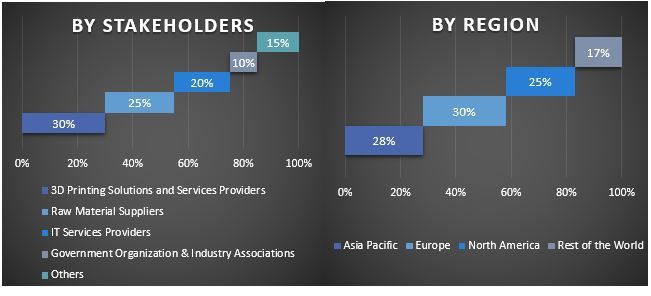
Market Engineering
The data triangulation technique was employed to complete the overall market estimation and to arrive at precise statistical numbers for each segment and sub-segment of the global 3D Printing. Data was split into several segments and sub-segments after studying various parameters and trends in the component, technology, application, end-users, and regions of the global 3D Printing market.
The current & future market trends of global 3D Printing were pinpointed in the study. Investors can gain strategic insights to base their discretion for investments on the qualitative and quantitative analysis performed in the study. Current and future market trends determined the overall attractiveness of the market at a regional level, providing a platform for the industrial participant to exploit the untapped market to benefit from a first-mover advantage. Other quantitative goals of the studies include:

Q1: What is the global 3D Printing's current size and growth potential?
Q2: What are the driving factors for the growth of global 3D Printing?
Q3: Which segment has the largest share of the global 3D Printing by component?
Q4: What are the emerging technologies and trends in global 3D Printing?
Q5: Which region will dominate the global 3D Printing?
Customers who bought this item also bought